What is the purpose of blocking wind on your patio?
When it comes to designing and enjoying your outdoor living space, wind can be a pesky annoyance that keeps you from fully enjoying your patio and outdoor furniture. Whether you’re trying to create a cozy atmosphere for entertaining guests or simply trying to relax and read a book outside, a strong wind can quickly ruin the mood.
But wind can be more than just a minor inconvenience. In areas with colder climates, gusty winds can make outdoor temperatures feel much colder than they really are, making it difficult to spend time outside during the cooler months. Heavy winds can also cause damage to outdoor furniture, plants, and other outdoor decor items, potentially resulting in costly repairs.
By blocking wind on your patio, you not only create a more enjoyable and comfortable outdoor living space but also protect your investment in your outdoor furniture and decor. There are a variety of effective methods and products available to help you minimize the impact of wind on your patio, from natural wind blockers like hedges and trees to temporary solutions like privacy screens and curtains.
No matter which method you choose, the purpose of blocking wind on your patio is to create a peaceful, comfortable outdoor environment that you can enjoy year-round.
What are the benefits of wind protection?
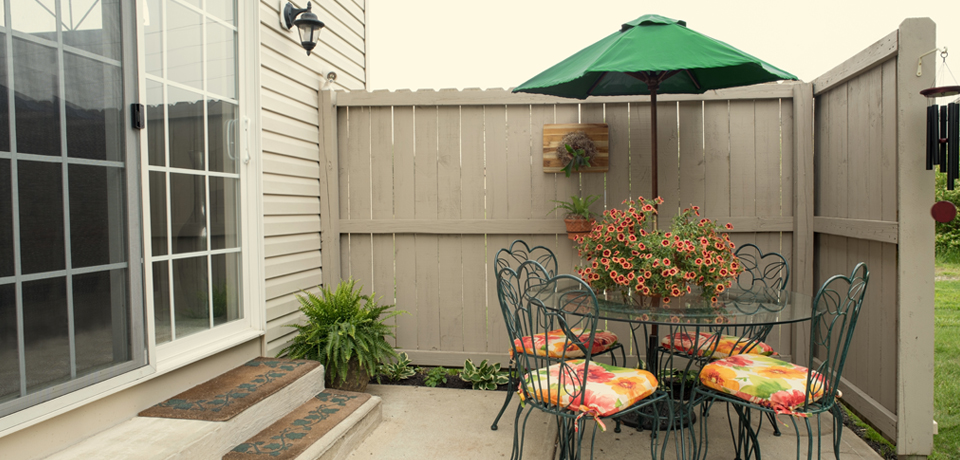
Wind is a natural occurrence that can have a significant impact on our outdoor living spaces. While cool breezes on a warm summer day can be inviting and refreshing, gusty winds can be much less pleasant, making it uncomfortable to spend time outside and potentially damaging your outdoor furniture and decor. That’s why investing in wind protection for your patio can be such a smart decision.
One of the primary benefits of wind protection is that it allows you to enjoy your outdoor living space more fully. When wind is constantly whipping through your patio area, it can be difficult to relax and enjoy the fresh air. But when you have effective wind protection in place, you can enjoy your patio space even on windy days, without feeling buffeted around or constantly having to hold onto your belongings.
In areas with colder climates, wind protection is especially important, because gusty winds can make outdoor temperatures feel much colder than they really are. By blocking these winds, you can make your outdoor space much more comfortable during cooler months, allowing you to spend more time outside and enjoy your patio even as the weather cools down.
Wind protection also helps to safeguard your outdoor furniture and decor. Heavy winds can cause damage to items on your patio, potentially resulting in costly repairs or replacements. By investing in wind protection, you can help to minimize this damage and protect your investment in your outdoor living space.
There are a variety of effective methods and products available to help you minimize the impact of wind on your patio. From natural wind blockers like hedges and trees to temporary solutions like privacy screens and curtains, there are options that can fit any budget and style preference.
Ultimately, the benefits of wind protection are clear: a more enjoyable outdoor living space, increased comfort in chilly weather, and protection for your outdoor furniture and decor. By investing in wind protection for your patio, you can create a more functional and enjoyable living space that you’ll love spending time in.
Identifying Wind Conditions
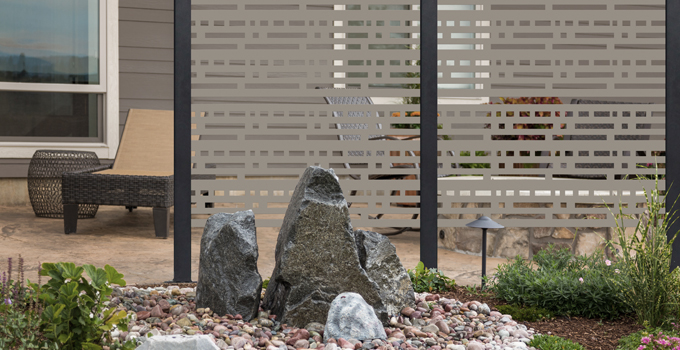
Before you can effectively block wind on your patio, it’s important to understand the wind conditions you’re dealing with. Different wind speeds and directions can require different types of wind protection, and failing to properly identify wind conditions can lead to ineffective or even dangerous wind protection solutions. Here are some key factors to consider when identifying wind conditions:
1. Wind Speed: The speed of the wind is one of the primary factors to consider when identifying wind conditions. Wind speeds are often measured in miles per hour (mph) or kilometers per hour (km/h), and can range from mild breezes to gusts of 70 mph or higher. Wind speeds can impact the stability of different wind protection solutions, with stronger winds requiring sturdier barriers.
2. Wind Direction: The direction of the wind can also play a significant role in identifying wind conditions. Winds can come from different directions based on weather patterns, geography, and other factors. Identifying the direction of the wind can help you determine where to place wind blockers and how to orient them for maximum effectiveness.
3. Temperature: The temperature and other weather conditions can impact wind conditions as well. For example, cold air can create gusty winds in certain areas, while warm air can contribute to more stable winds. Understanding how weather conditions affect wind can help you better identify wind conditions and choose the right wind protection solutions.
4. Landscape: The landscape surrounding your patio area can also impact wind conditions. Trees, hills, buildings, and other structures can impact the flow of air, creating areas with higher or lower wind speeds and directions. Understanding the landscape can help you identify areas that are more susceptible to wind and determine the best wind protection solutions for those areas.
By taking these factors into consideration, you can more effectively identify wind conditions and choose the right wind protection solutions for your patio area. Whether you opt for natural wind blockers like hedges and trees or invest in temporary windbreakers like privacy screens or roll-down curtains, understanding the wind conditions in your area is a critical first step in creating a comfortable and protected outdoor living space.
How to assess wind conditions in your area?
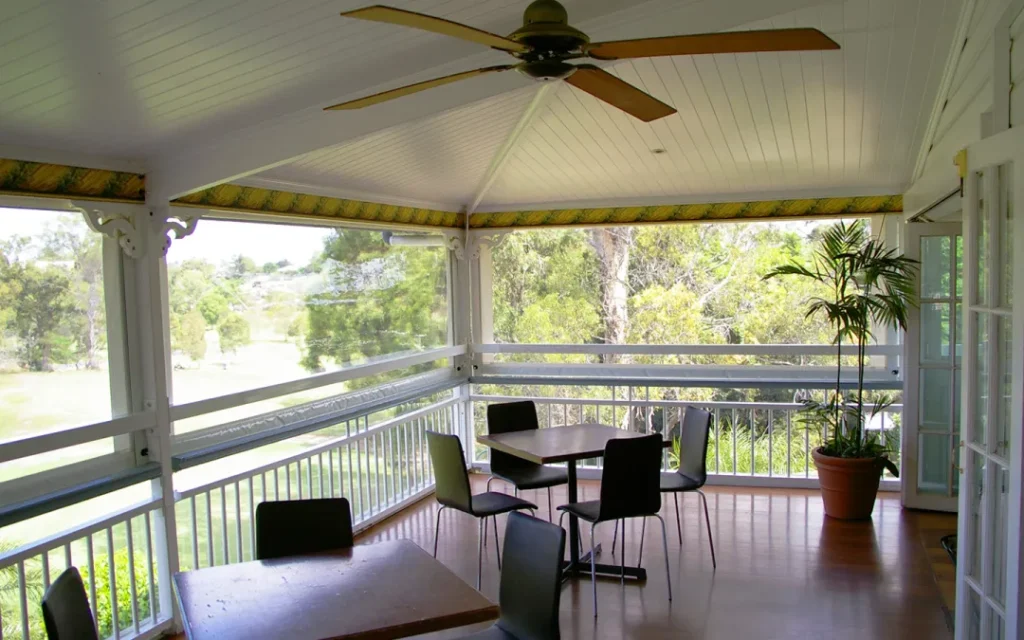
Wind conditions can greatly affect the comfort and safety of outdoor spaces. Whether you have a patio, deck, or any other kind of outdoor area, it’s important to assess the wind conditions in your area to determine the level of wind protection you need. Here are some steps to help you assess wind conditions in your area:
1. Look up the wind speed and direction: You can check online for local weather reports that provide information about wind speed and direction. This will give you a general idea of the wind conditions in your area, but keep in mind that wind conditions can vary within a small geographic area due to the landscape and other factors.
2. Observe the landscape: Take a walk around your outdoor area and observe the landscape. Notice any trees, hills, buildings or other structures that could impact wind flow. These factors can create areas with higher or lower wind speed and direction. Identifying these areas can help you choose the best wind protection solutions.
3. Notice the movement of objects: Observe any objects in your outdoor area that move with wind, such as flags, plants or hanging decorations. Notice how they move in different wind speeds and directions, as this can give you an indication of the wind conditions in your area.
4. Use wind measurement tools: If you’re looking for a more precise assessment of wind conditions, you can use wind measurement tools such as an anemometer or handheld wind meter. These tools will provide you with an accurate reading of wind speed and direction in your area.
5. Pay attention to local history: If you’ve lived in your area for some time, you may have experienced heavy wind events in the past. Take note of any previous incidents and the damage caused by heavy winds. This can help you assess the level of wind protection you need for your outdoor area.
Assessing wind conditions in your area is an important step in determining the best wind protection solutions for your outdoor area. By taking the time to study the wind conditions, you can select solutions that are best suited to your specific needs, ensuring you can enjoy your outdoor space comfortably and safely.
Factors to Consider for Wind Protection
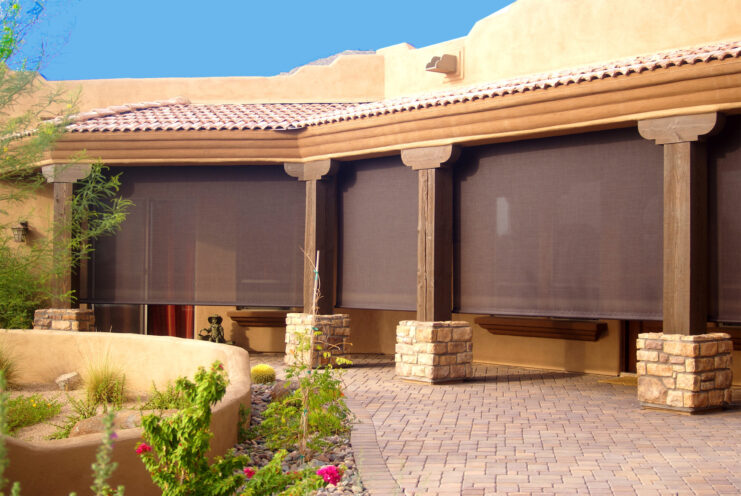
When designing or retrofitting an outdoor living space, one of the primary concerns is wind protection. Strong winds can make outdoor spaces uncomfortable and potentially dangerous, blowing over furniture or damage to the structure itself. Here are some factors to consider when deciding on the best wind protection options for your patio, deck or outdoor living space:
1. Wind conditions: Understanding the wind conditions in your area is essential for selecting the right wind protection solution. You should be aware of the average wind speed and direction in your area. You can check online for local weather reports that provide information about wind speed and direction. This will give you a general idea of the wind conditions in your area, which will help you choose the best wind protection solution.
2. Landscape: The layout of your outdoor area can significantly impact the wind’s strength and direction. Natural wind blockers, such as trees or hills, can help reduce the strength of the wind or even change direction. However, they may not be enough in severe wind conditions. You could consider using additional wind protection solutions like lattice panels, railing panels, artificial hedge walls, or outdoor shades.
3. Building structure: The structure of your building can also impact the wind conditions of your outdoor space. For instance, if your home is tall and close to your patio or deck, it can create a wind tunnel, increasing the wind’s strength. You need to consider the structure’s orientation and roof design to reduce the wind’s impact on your outdoor space.
4. Patio cover: A patio cover or roof can provide excellent wind protection for your outdoor living space. It can offer adequate wind protection without sacrificing natural light. You might consider installing roll-down wind protection or outdoor shades that can be adjusted according to your needs.
5. Windbreak hedge: Planting a windbreak hedge can provide a natural wall barrier protecting your outdoor living space from strong winds. Using trees, such as maple trees, is an excellent option as they can adjust and grow according to the wind’s pattern, and they add a natural look to your outdoor living space.
6. Outdoor furniture: Using heavy-duty outdoor furniture or anchoring the furniture can help protect them from getting blown over during strong winds.
In conclusion, wind protection is an essential factor to consider when designing your outdoor living space. You can protect your outdoor space from strong winds by considering the wind conditions, landscape, building structure, patio cover, windbreak hedge, and outdoor furniture. By implementing the right wind protection solutions, you’ll be able to create a comfortable and safe outdoor living space.
Understanding Wind Speeds to Choose an Appropriate Solution
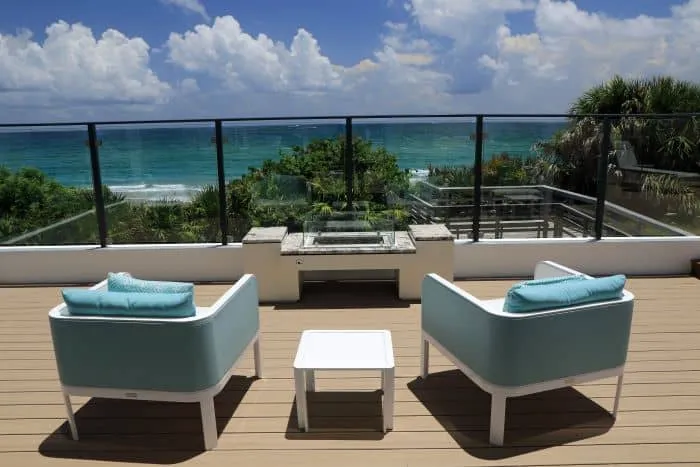
When you’re trying to block wind on your patio, it’s important to understand the wind speeds in your area. Wind speed is measured in miles per hour (MPH) or kilometers per hour (KPH) and is often categorized into different ranges.
Understanding these wind speed ranges is crucial for selecting the right wind protection solution. Here’s a breakdown of the different wind speed ranges and what they mean:
– Mild Winds: These are winds that range from 0-10 MPH (0-16 KPH). At this speed, you may feel a slight breeze, but it’s generally not strong enough to cause any damage or discomfort.
– Light Winds: These are winds that range from 11-20 MPH (17-32 KPH). At this speed, you may feel a moderate breeze, and lightweight objects like patio cushions or furniture covers may start to move around.
– Stronger Winds: These are winds that range from 21-30 MPH (33-48 KPH). At this speed, you may feel a strong breeze, and larger objects like patio furniture or potted plants may start to topple over.
– Heavy Winds: These are winds that range from 31-45 MPH (49-72 KPH). At this speed, you may feel very strong winds that can cause significant damage to outdoor structures and furniture.
– Gusts: These are short bursts of stronger winds that can occur at any wind speed. Gusts can be particularly dangerous for outdoor structures and furniture because they can suddenly increase the wind’s effectiveness.
So, now that you understand the different wind speed ranges, how do you choose an appropriate wind protection solution? The answer depends on your specific situation. In areas with mild or light winds, a simple privacy screen or patio wind blocker may be enough to provide adequate protection. However, in areas with stronger winds, you may need more robust solutions like lattice panels, artificial hedge walls, or even roll-down wind protection.
Ultimately, understanding the wind conditions in your area is key to selecting the right wind protection solution for your patio. Keep in mind that wind speeds can vary greatly depending on location, so be sure to research your local weather conditions before making any final decisions.
Natural Wind Blockers
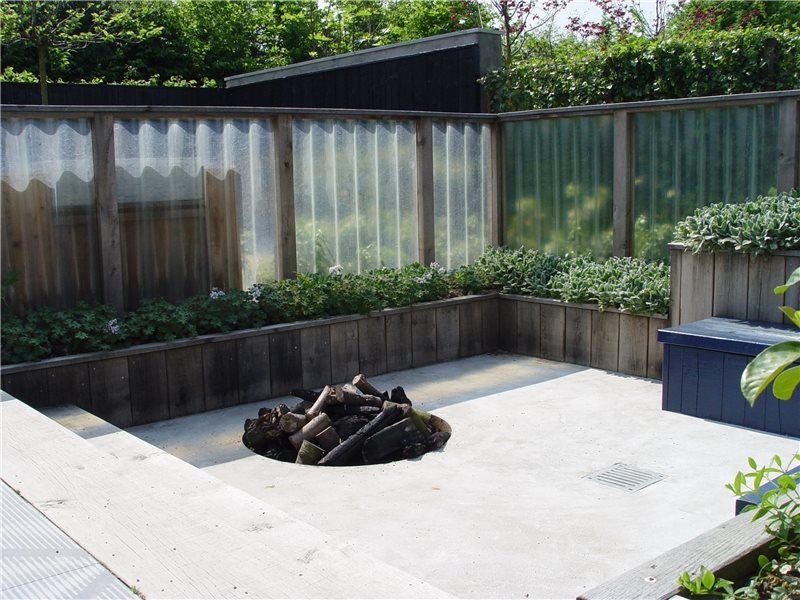
If you have an outdoor space that you enjoy spending time in, then you know how important it is to have some form of wind protection. Wind can quickly ruin your outdoor experience by making it colder, blowing things around, and even damaging your furniture or other fixtures. While there are several wind protection solutions available in the market, natural wind blockers can be an effective and aesthetically pleasing choice.
What are Natural Wind Blockers?
Natural wind blockers are basically plants or other natural elements that are strategically placed to block or slow down the wind. For centuries, people have used natural wind blockers like trees, shrubs, and hedges to protect their homes and outdoor spaces from the wind. Not only do they provide an effective solution for blocking the wind, but they also add beauty and natural appeal to any outdoor space.
Benefits of Natural Wind Blockers
1. Effective Wind Protection – Natural wind blockers can effectively block or slow down the wind, which can make your outdoor experience more comfortable and enjoyable. They can also serve as a barrier against dust and debris.
2. Aesthetically Pleasing – Natural wind blockers can add beauty and visual appeal to your outdoor space. They come in various colors and sizes, providing a wide range of options to suit individual tastes and preferences.
3. Environmentally Friendly – Natural wind blockers are an eco-friendly and sustainable solution for wind protection. They help to reduce wind erosion and provide habitats for various wildlife species.
Types of Natural Wind Blockers
There are various types of natural wind blockers that you can use in your outdoor space. These include:
1. Trees -Trees are an excellent natural wind blocker that provides shade, visual appeal, and ecological benefits. The best types of trees for wind protection are deciduous trees such as maple, oak, and birch.
2. Shrubs – Shrubs are smaller than trees and can be placed to create a windbreak. Some of the best wind-blocking shrubs include boxwoods, yews, and viburnums.
3. Hedges – Hedges are a natural fence made from tightly packed shrubs that provide an effective wind barrier. The best hedges for wind protection include privet, beech, and hedge maple.
In conclusion, natural wind blockers are an effective solution for outdoor spaces that provide wind protection while also adding beauty and natural appeal. Whether you opt for trees, shrubs, or hedges, natural wind blockers are an eco-friendly and sustainable solution that can enhance your outdoor experience.
Heavy Winds: Planting a Windbreak Hedge or Artificial Hedge Wall
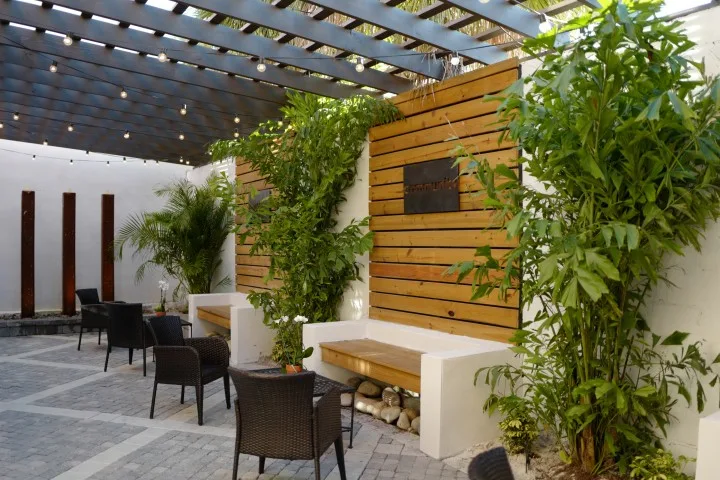
When it comes to heavy winds, it can be difficult to enjoy your outdoor space without feeling constantly battered by the gusts. A strong windbreak hedge or artificial hedge wall can provide effective and attractive protection against the elements.
Planting a windbreak hedge is a natural solution for wind protection. The key is to select hardy shrubs or trees that can withstand high winds and have a dense growth habit, providing an effective barrier against the wind. Some popular choices for windbreak hedges include evergreens like juniper, cedar, and pine, as well as deciduous trees such as oak and maple. It’s important to choose the right location for your hedge, planting it perpendicular to the prevailing winds and leaving enough space to allow for healthy growth and maintenance.
For those who prefer a more low-maintenance solution or don’t have space for a traditional windbreak hedge, an artificial hedge wall can also be an effective option. Made of dense, synthetic materials designed to emulate the look and feel of natural hedges, artificial hedge walls are durable, versatile, and can be easily customized to fit any outdoor space. They can be installed as a permanent fixture or as a temporary solution for events and gatherings.
Whether you choose a natural windbreak hedge or an artificial hedge wall, the benefits of investing in wind protection are clear. You’ll be able to enjoy your outdoor space without worrying about wind damage to furniture or landscaping, and you’ll have the added benefit of privacy and noise reduction. Plus, with the variety of options available, you’re sure to find a solution that fits your style and needs.
Mild Winds: Placing Potted Plants Around Your Patio
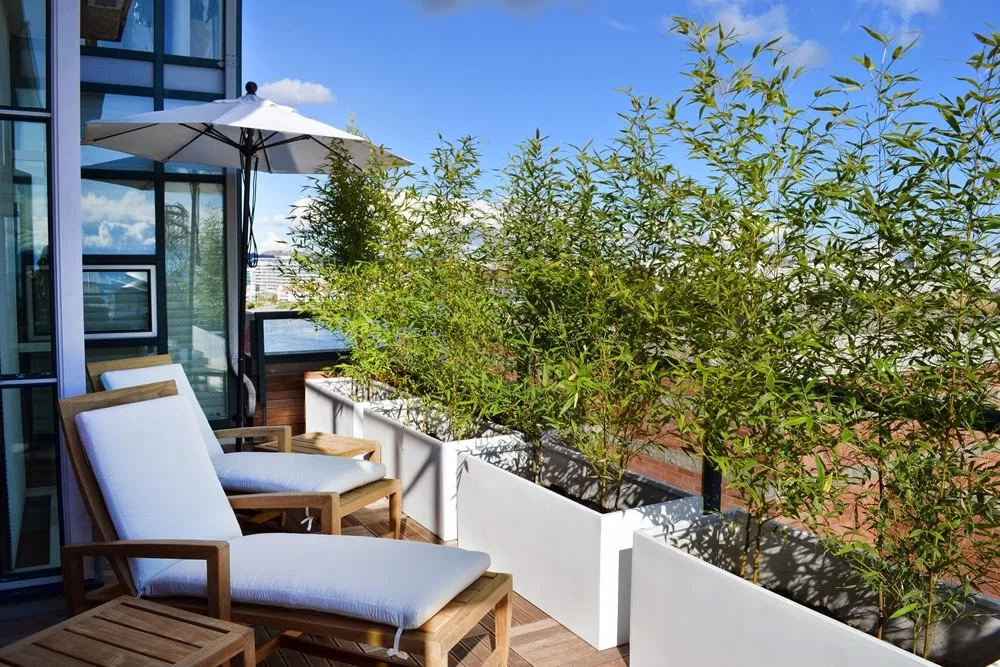
If you’re dealing with mild winds on your patio and are looking for an aesthetically pleasing solution, placing potted plants around your outdoor space is a great option.
Not only do potted plants add a pop of color and texture to your patio, but they can also act as a natural wind blocker. By strategically placing larger potted plants in areas where wind tends to be more prevalent, like corners or along the edges of your patio, you can create a natural barrier that helps keep the wind at bay.
While it’s important to choose plants that will thrive in the specific conditions of your patio (such as the amount of sunlight and moisture available), there are several types of plants that are known for their wind-blocking capabilities. Consider plants with dense foliage such as boxwood, holly, or yew. These plants are not only sturdy and able to withstand windy conditions, but their dense leaves and branches can also help to deflect wind.
In addition to potted plants, another great option for mild wind protection is a privacy screen or outdoor shade. These can be a bit more expensive and difficult to install, but provide a more permanent and effective solution for keeping the wind from bothering you on your patio.
Overall, by incorporating potted plants or other natural elements into your patio design, you can create a beautiful and functional space that provides mild wind protection while adding a touch of greenery to your outdoor oasis.
Any Weather Climate: Installing an Outdoor Shade Structure or Privacy Screen
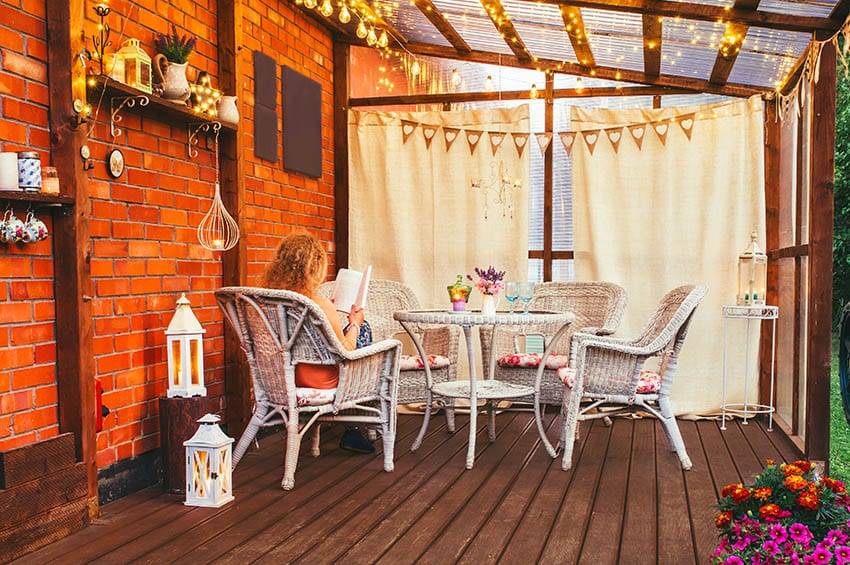
If you have an outdoor living space that you love to enjoy year-round, then you know how important it is to have protection from the elements. Whether it’s the hot sun in the summer or the cold wind and rain in the winter, having an outdoor shade structure or privacy screen can make a big difference in your comfort level and enjoyment of your patio or deck.
One of the most popular options for outdoor shade structures is a pergola. These structures are typically made of wood or vinyl and feature an open-air design with a slatted roof that provides both shade and ventilation. Pergolas can be customized to fit the style and aesthetics of your outdoor space, and can even be outfitted with curtains or drapes for added privacy.
Another option for outdoor shade is a retractable awning. These structures are typically made of fabric and can be extended or retracted as needed to provide shade and protection from the elements. Retractable awnings can be installed on a variety of outdoor structures, including decks, porches, and patios.
If privacy is your main concern, then a privacy screen may be the right choice for you. These screens can be made of a variety of materials, including wood, vinyl, or metal, and can be customized to fit the size and shape of your outdoor space. Some privacy screens even come with built-in planter boxes or shelves for added functionality.
No matter what type of outdoor shade structure or privacy screen you choose, it’s important to work with a professional installer who can ensure that the structure is safe, secure, and up to code. Be sure to do your research and choose a reputable contractor who has experience working with the specific type of structure you are interested in.
With the right outdoor shade structure or privacy screen, you can enjoy your outdoor living space in any weather climate, from the sunny days of summer to the cold winter months. So why wait? Start exploring your options today and enjoy a more comfortable and enjoyable outdoor living experience all year long.
Portable Solutions for Maximum Flexibility
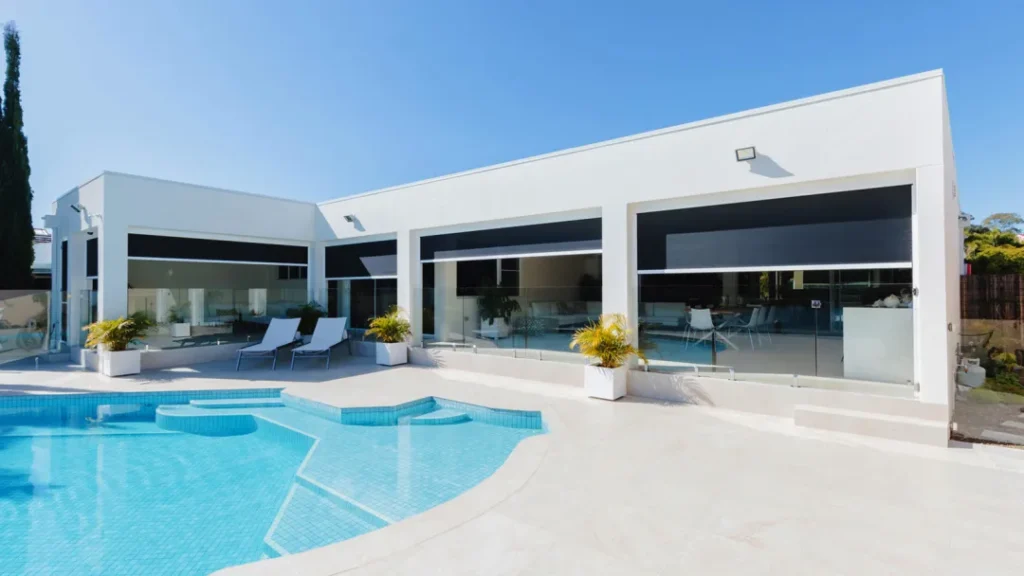
If you’re someone who loves spending time outdoors, whether it’s on your patio, balcony, or in your backyard, then you know how important it is to have some form of protection from the elements. Wind, rain, and sun can all impact your comfort and enjoyment, and nobody wants to be forced inside because of the weather. Fortunately, there are a variety of portable solutions available that can help you maximize your time outdoors while still giving you the flexibility you need.
One popular option for wind protection is a portable wind block. These blockers often come in the form of panels or screens that can be placed strategically around your outdoor space to create a barrier against strong winds. Whether you opt for lattice panels, railing panels, or even artificial hedge walls, a wind block can make a huge difference in how comfortable and enjoyable your time outside is. Not only will it help keep gusty winds at bay, but it can also provide added privacy and a touch of natural beauty.
Another portable solution for maximizing your flexibility outdoors is a retractable shade or awning. These shades can be attached to any structure, whether it’s a pergola, deck, or even an umbrella, and can be extended or retracted as needed to provide shade and protection from the hot sun. Not only will a retractable shade help keep you cool and comfortable on hot days, but it can also provide added privacy and a cozy, intimate atmosphere.
For those who live in cold weather climates, a portable wind break can be a lifesaver. These breaks often come in the form of vinyl or PVC curtains that can be hung from an existing structure like a pergola or outdoor canopy. They create a barrier against cold, winter winds, helping to keep you and your guests warm and comfortable. Plus, they can be rolled up and stored away when not in use, giving you maximum flexibility.
No matter what type of portable solution you choose for your outdoor space, be sure to do your research and choose a high-quality product that will provide you with the protection and flexibility you need. With the right wind blocker, retractable shade, or wind break, you can take your outdoor enjoyment to the next level and make the most of your time outside.
Portable Lattice Panels and Railing Panels for Quick Installation
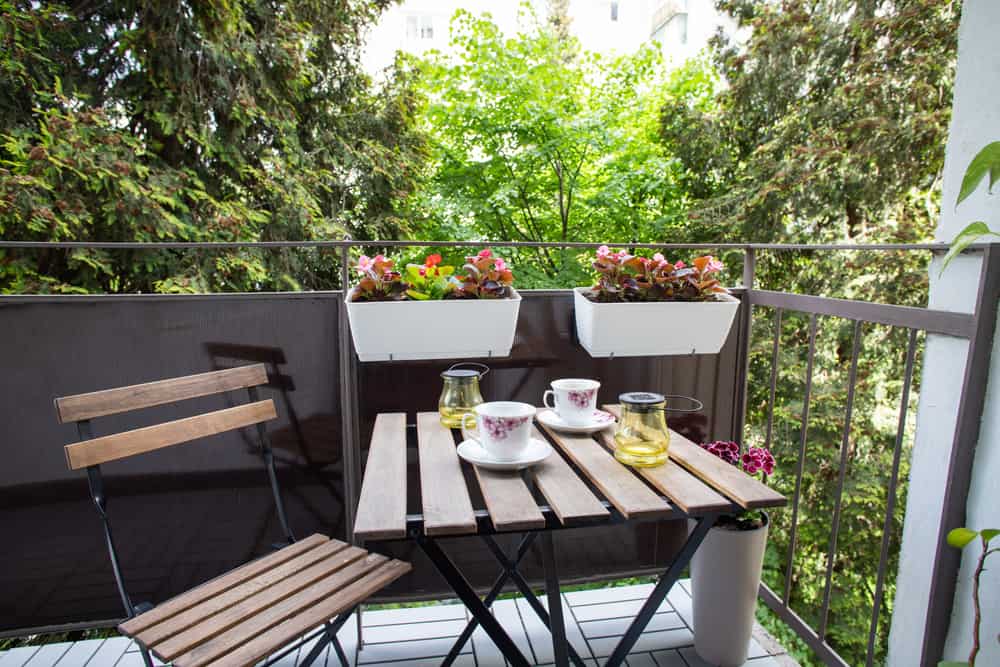
If you’re looking for a quick and easy way to block the wind on your patio or outdoor space, look no further than portable lattice panels and railing panels. These panels are a popular solution for wind protection, as they can be easily installed and moved around as needed.
Lattice panels, which are made from criss-crossing strips of wood or plastic, can be attached to an existing structure like a fence or pergola, creating a beautiful and functional wind block. These panels come in a variety of sizes and styles, so you can choose the perfect match for your outdoor space. Plus, they’re lightweight and easy to move around, so you can adjust them as needed to suit your changing wind conditions.
Railing panels, on the other hand, are designed to attach to the railing of your patio or deck, creating a wind block without the need for any additional structures. These panels are typically made from materials like glass, metal, or wood, and can be customized to match the style of your outdoor space. Like lattice panels, they’re easy to move around and provide added privacy, making them a popular choice for homeowners who love to entertain outdoors.
Both lattice panels and railing panels offer quick installation and maximum flexibility, making them an ideal choice for those who want easy wind protection without the hassle of a permanent structure. Plus, they add a touch of visual interest to your outdoor space, enhancing its beauty and functionality. So, whether you’re looking to block out stronger winds or simply create a cozy, private atmosphere on your patio, consider portable lattice or railing panels for a quick and easy solution.
Artificial Hedge Walls for Easy Portability and Setup
If you’re looking for a quick and easy solution to block the wind on your patio, artificial hedge walls may be just what you’re looking for. These versatile and portable panels are available in a variety of sizes and styles, making it easy to find the perfect match for your outdoor space.
One of the best things about artificial hedge walls is that they offer an attractive and natural-looking wind block without the need for any construction. Instead of relying on lattice or railing panels, which require a stable and secure structure to mount onto, artificial hedge walls can be easily installed in seconds. Most models come with built-in stands, which means they can be placed anywhere on your patio or deck without the need to drill or screw them into place.
Another great feature of artificial hedge walls is their portability. Unlike traditional wind blockers, which can be heavy and difficult to move around, artificial hedge walls are designed to be lightweight and easy to transport. They can be easily stored during the off-season or moved to different spots around your patio depending on your specific wind conditions.
Artificial hedge walls are also ideal for homeowners who want a wind block that does not compromise natural light. Since these panels are made from faux foliage, they allow natural light to filter through while still blocking the wind and providing privacy. They’re also great for use in cold weather climates, where they can help to insulate your patio and keep outdoor heating costs down.
Ultimately, whether you’re dealing with strong winds or just light gusty breezes, artificial hedge walls are a great choice for anyone looking for an easy-to-use and portable wind blocker. With their natural-looking foliage, lightweight construction, and easy setup, they offer a simple and affordable solution for improving your outdoor living space.
Outdoor Shades That Can be Easily Removed
If you’re someone who loves spending time outside, you know that having a comfortable and shaded outdoor area is essential for enjoying your time outdoors. Whether you’re looking to block out harmful UV rays, keep the sun glare to a minimum, or simply create a cozy and inviting space to relax in, outdoor shades can be a great solution. But what if you want the option to easily remove your outdoor shades when you want more sun? Fortunately, there are plenty of outdoor shade options that can be easily removed, so you can have the best of both worlds.
Roll-Up Shades
Roll-up shades are a popular choice for outdoor spaces because they are easy to install, can be customized to fit your specific needs, and can be easily removed when not in use. These shades are made from a variety of materials ranging from vinyl to mesh and come in a wide range of colors and patterns. They can be mounted to your patio or deck with simple brackets and a few screws, and when you want to remove them, you can simply unroll the shades and store them away until the next time you need them.
Retractable Awnings
Retractable awnings are another great option for outdoor shade that can be easily removed. These awnings are attached to your home or patio cover and can be extended or retracted with the push of a button. When you’re not using the awning, it can be quickly and easily retracted, leaving your outdoor space open to the elements. Retractable awnings come in a variety of sizes, colors, and styles, so you’re sure to find one that matches your home’s aesthetic.
Umbrellas
Umbrellas are a classic choice for outdoor shade, and they’re also incredibly easy to remove. Unlike roll-up shades or retractable awnings, umbrellas are completely portable and can be moved around your outdoor space as needed. When you’re not using your umbrella, you can simply fold it up and store it away until the next time you need it. Umbrellas come in a variety of sizes and styles, so whether you’re looking for a small patio umbrella or a large cantilever umbrella, there’s sure to be an option that fits your needs.
In conclusion, outdoor shades are an essential addition to any outdoor space, providing protection from the sun, wind, and rain. With these easily removable options, you can have the functionality you need and the flexibility you want in your outdoor space. So why not invest in a solution that works for you and your lifestyle today?
Permanent Structures to Withstand Stronger Winds
When it comes to enjoying your outdoor space, having a patio or deck can be a great addition to your home. However, if you live in an area with stronger winds, it’s important to ensure that your outdoor space is properly protected. While removable options like roll-up shades or umbrellas are convenient, they may not be enough to withstand more severe weather conditions. In these cases, you may want to consider permanent structures that can provide the wind protection you need.
One popular option for wind protection is a wind block fence. These fences are designed with slats that allow air to pass through, reducing the risk of the fence toppling over in high winds. Wind block fences can be made from a variety of materials, including wood, vinyl, or metal, and can be customized to match your home’s aesthetic.
Another option is to install lattice or railing panels. These panels can not only provide wind protection but also add a decorative element to your patio or deck. Lattice panels are made from thin strips of wood or vinyl that are woven together, while railing panels are typically made from metal or glass. Both options allow air to pass through while still providing a barrier for stronger gusts of wind.
If you’re looking for a more natural wind blocker, consider planting a windbreak hedge or potted plants. A windbreak hedge is a row of trees or bushes that can help reduce wind speeds by blocking and diverting airflow. Potted plants can also help break up strong gusts of wind while bringing some natural beauty to your outdoor space.
For those living in cold weather climates, a glass patio enclosure or outdoor shades made from thicker materials can help keep wind and cold weather elements at bay. These structures can be customized to fit your patio or deck and can provide a more permanent solution to keep the wind out.
When it comes to withstanding stronger winds, it’s important to choose permanent structures that are durable and built to last. Whether you opt for a wind block fence, lattice panels, windbreak hedge, or glass enclosure, investing in a permanent solution can provide long-lasting wind protection for your outdoor space.




